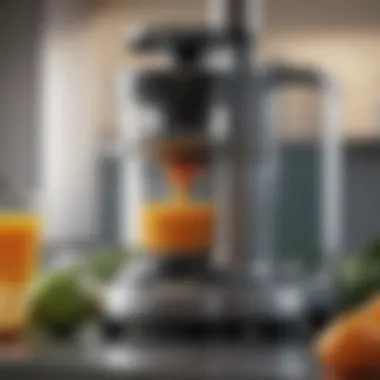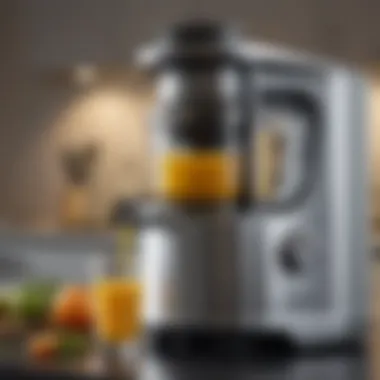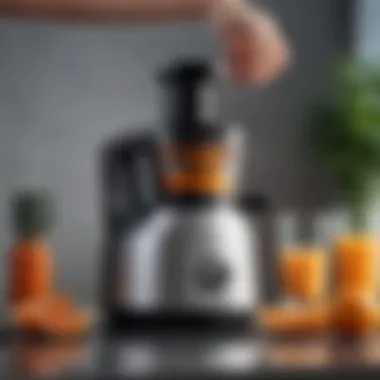Understanding the Breville Juicer Screen for Optimal Performance


Intro
Understanding the intricacies of the Breville juicer screen is essential for any enthusiast looking to maximize their juicing experience. The screen plays a crucial role in the juice extraction process, influencing both the yield and clarity of the juice. By delving into its functions, users can not only appreciate its design but also recognize common issues and maintenance tips that can enhance performance. This article serves as a comprehensive guide, aimed at providing insights that help consumers make informed decisions regarding their Breville juicer.
Design Inspirations
Trending Styles
The design of Breville juicer screens reflects both functionality and aesthetics. Breville has consistently embraced modern, sleek designs, appealing to both professional chefs and home enthusiasts. The metallic finish of the screens not only ensures durability but also adds a touch of elegance to kitchen spaces. Users may find various designs, from minimalist to more intricate patterns that complement the overall cooking experience.
Color Palettes
Color is a subtle yet significant aspect of kitchen design. While Breville juicers are typically available in standard metallic hues, there are some color variations that cater to diverse household themes. Consumers who value aesthetics might consider how their juicer's screen and overall appliance color can fit within the broader palette of their kitchen. A cohesive color scheme can enhance the kitchen's functionality and appeal.
Maintenance and Upkeep
Seasonal Maintenance Checklist
To ensure optimal performance of the Breville juicer, here are essential maintenance steps:
- Regular Inspection: Check the screen for wear and tear, and replace if necessary.
- Cleaning: Clean the screen thoroughly after each use to prevent build-up.
- Gasket Check: Examine the gasket for any cracks or damage to maintain a good seal.
- Store Properly: When not in use, store the juicer and its components in a dry area to prevent moisture damage.
These adjustments can significantly improve the longevity of the juicer while maintaining its performance levels.
Cleaning and Organization Tips
Keeping the juicer screen clean and organized is vital:
- Immediate Rinse: Rinse the screen immediately after juicing to remove pulp residue.
- Use Soft Brushes: Employ a soft brush for detailed cleaning without scratching the surface.
- Create a Cleaning Schedule: Set a regular cleaning routine to make upkeep manageable.
- Organize Accessories: Keep juicer accessories in designated storage to avoid misplacement.
Integrating these practices into your routine can prevent common issues and ensure the juicer works effectively for years to come.
"Maintenance is not just about fixing issues; it is about preventing them."
By emphasizing both design and maintenance aspects, this guide aims to enhance your understanding of the Breville juicer screen. Applying the knowledge acquired here can pave the way for achieving better juicing experiences.
The Role of the Juicer Screen
The juicer screen serves a critical function in the overall performance of Breville juicers. Its primary purpose is to separate juice from pulp, ensuring that only the liquid enters your glass. This aspect is vital because the quality of juice directly relies on how well the screen performs its filtering task. A well-functioning juicer screen can significantly enhance juice yield, enriching the overall juicing experience.
Understanding juice extraction is crucial as it allows users to maximize their juicing efforts. The design and mesh size of the screen can influence not just how much juice is extracted, but also the texture and clarity of the final product. Fine screens can produce smoother juices by minimizing pulp, while coarse screens allow for more fiber, which some consumers find appealing. This relationship between screen design and juicing results cannot be overstated and is a key consideration for both new and seasoned juicers.
Understanding Juice Extraction
Juice extraction is a fundamental process that encapsulates the mechanical breakdown of fruits and vegetables to release their liquids. Breville juicers utilize different techniques depending on the screen type, and the selection of the screen can affect yield and taste. During the extraction process, fruits experience pressure, leading to the rupture of cell walls and the release of juice.
A precise balance in extraction is often required. Too much extraction can lead to unappealing textures while too little can result in wastage of juice. Selecting the correct juicer screen can lead to optimal extraction. Users need to familiarize themselves with the various kinds of produce and how they interact with different screens to adjust their approach for maximum benefit.
Material Composition of Juicer Screens
The material of the juicer screen is as vital as its design. Breville typically employs stainless steel in their juicer screens due to its durability and resistance to rust. This choice reflects the brand’s commitment to quality and longevity, which is critical as screens endure significant wear and tear during usage.
Some juicer screens may incorporate plastic or other materials, but they often do not offer the same durability or performance. Stainless steel screens are easier to clean, reducing the chances of food build-up that might affect flavor and health. Consumers are advised to choose a model with high-quality screen material to ensure the best results.
Types of Breville Juicer Screens
When discussing juicing, the type of screen used is crucial to both the extraction process and the quality of the juice produced. Breville offers various juicer screens tailored to different juicing needs. Understanding these types allows users to make informed choices, enhancing both flavor and nourishment from juices.
Fine Mesh Screens
Fine mesh screens are designed to extract juice with minimal pulp. They are ideal for juicing soft fruits, leafy greens, and certain vegetables. This screen type creates a smoother texture, which many consumers prefer. Fine mesh screens can enhance the overall juice quality by ensuring a purer liquid without unwanted solids. However, they may require more frequent cleaning, as smaller particles can easily clog the mesh. This could lead to decreased efficiency over time.


Coarse Mesh Screens
Coarse mesh screens provide a different approach to juicing by allowing more pulp into the juice. They are excellent for juicing hard fruits and vegetables like apples and carrots. The increased fiber content can offer health benefits. Additionally, using coarse mesh screens can yield a fuller-bodied juice. While they may not produce as smooth a liquid as fine mesh screens, many users appreciate the added texture. Like fine mesh screens, they also have cleaning considerations. They tend to be less likely to clog but can still accumulate residue.
Specialized Screens for Different Juicing Needs
Breville has also developed specialized screens suited for specific juicing tasks. For example, some screens are meant for citrus fruits, while others cater to nut milks or smoothies. These screens often incorporate unique designs to achieve the best results for particular ingredients.
Using specialized screens ensures optimal extraction and flavor. It also allows users to explore a wider range of juicing possibilities. Varieties such as dual-purpose screens can serve both hard and soft fruits effectively. Paying attention to screen specifications can greatly impact your juicing experience.
In summary, selecting the right type of Breville juicer screen can influence not only the performance of the juicer but also the quality and enjoyment of the juice itself. Understanding the options available helps users tailor their juicing experience to meet personal preferences.
Common Issues with Breville Juicer Screens
Understanding the common issues related to Breville juicer screens is crucial for any user aiming to maintain their juicer's performance and longevity. Many factors can affect how well a juicer screen performs, and recognizing these issues can lead to more effective usage. Users can prevent future problems and extend the lifespan of their juicers by being aware of the potential challenges. Addressing these issues not only improves juice quality but also enhances the overall juicing experience.
Clogging and Its Causes
Clogging is a frequent issue faced by juicer users. It happens when the screen's mesh becomes obstructed with pulp and fiber from fruits and vegetables. When the screen clogs, several problems arise. First, the juice yield decreases. You might notice that the appliance takes longer to process ingredients and yields less juice than normal. This is particularly troubling when you are trying to extract juice from harder vegetables like carrots or beets.
Several factors contribute to clogging. One major cause is the type of produce being juiced. Fibrous vegetables or overly ripe fruits tend to create more pulp, resulting in finer particles getting stuck in the mesh. Additionally, not cutting fruits and vegetables into uniform pieces can further contribute to uneven juicing and clogging. Ensuring you prepare your ingredients properly can reduce this issue significantly.
Another reason for clogging is not cleaning the screen after each use. The remnants left behind can harden and stick, making it difficult to remove during the next cleaning. A simple rinse and thorough wash after each juicing session are effective strategies for maintaining a clean screen, thus avoiding the risk of clogs.
Wear and Tear Over Time
Wear and tear is another inevitable issue that comes with the use of Breville juicer screens. Over time, the materials used in the screen may degrade. This degradation can alter the mesh's size and structure, affecting its efficacy in juice extraction. Users will notice changes, such as an increase in foam or pulp in the juice, indicating that the screen is not functioning as it should.
Several factors accelerate wear and tear. Regular usage naturally causes the screen to wear down, but other elements can intensify this process. For instance, the quality of the produce being juiced can significantly impact the screen's lifespan. Ingredients that are tough, like nuts or certain seeds, can be particularly damaging if juiced incorrectly. Using the juicer for purposes other than its intended use, such as grinding or crushing, can also lead to quicker wear.
It's important to monitor the condition of the screen regularly. Users should inspect for any visible signs of damage such as scratches or holes. Identifying these issues early can prevent more significant problems down the line. If significant wear is noticed, it may be time to replace the screen to maintain optimal juicing performance. By understanding these common issues, users can take proactive steps to ensure their juicer screens remain efficient for longer.
Signs of a Worn Juicer Screen
Recognizing the signs of a worn juicer screen is crucial for optimizing your juicing experience. A screen that has seen better days can greatly affect juice yield and quality. If you ignore this aspect of maintenance, you could find yourself with disappointing results. Being aware of the indicators that suggest a screen may need attention will not only enhance your juice extraction process but also prolong the life of your Breville juicer.
Decreased Juice Yield
A prominent sign that a juicer screen is worn is a noticeable decrease in juice yield. If you find that you are producing less juice than usual when using the same amount of fruits or vegetables, this is an important red flag. A worn screen struggles to filter out pulp and other undesired materials effectively. As a result, a greater amount of produce may remain inside the juicing container after processing, leading to inefficiencies. Properly assessing your yield can guide you in determining when a replacement is necessary to ensure you are maximizing the juicing capabilities of your device.
Visible Damage and Scratches
Another significant indicator of wear is visible damage to the juicer screen itself. Scratches, dents, or cracks can have a direct impact on the juicing process. Imperfections on the surface can lead to problems in filtering, resulting in pulp contamination in your juice. Over time, these flaws weaken the screen’s structural integrity, making it less effective during operation. Regular inspection will help you catch these issues early, maintaining the overall performance of the juicer. If you notice any physical damage, it may be time to consider a replacement without delay.
Taking care of your juicer screen can ensure optimal performance and quality of your juice.
In summary, fostering an awareness of these signs will empower homeowners and juicing enthusiasts to keep their Breville juicers functioning beautifully, providing great-tasting juice with every use.
Maintaining Your Breville Juicer Screen
Maintaining your Breville juicer screen is crucial for both performance and longevity. A well-maintained screen ensures maximum juice extraction, retains flavor integrity, and prolongs the lifespan of the juicer itself. Neglecting regular maintenance can lead to reduced efficiency and potentially costly replacements. Therefore, understanding the best practices for care is essential for any juicing enthusiast.
Cleaning Techniques
Proper cleaning of the juicer screen is fundamental for maintaining its functionality. Here are effective techniques you should consider:
- Immediate Rinse: After juicing, rinse the screen with warm water. This prevents residue from drying and hardening, making it easier to clean later.
- Use of a Brush: Utilize a soft brush, ideally a dedicated juicer brush, to gently scrub the screen. This will help remove pulp and fibers that may be trapped in the mesh without causing damage.
- Soaking in Warm Soapy Water: For stubborn residues, soak the screen in a mix of warm water and mild dish soap for about 15 minutes. This will loosen any dried pulp.
- Avoid Abrasive Cleaners: Always avoid using steel wool or harsh chemical cleaners. These can scratch or damage the screen, affecting its performance.
- Dishwasher Compatibility: If applicable, check if your Breville screen is dishwasher safe. Some models can be safely washed in a dishwasher, saving time and effort.
By employing these techniques, you can maintain optimal juicer performance and ensure consistent juice quality.
Frequency of Cleaning
The frequency of cleaning your juicer screen depends on usage but consistency is key:


- After Each Use: It is best to clean the juicer screen after every juicing session. This avoids build-up and keeps the screen in top condition.
- Heavy Use: If you use your juicer daily or multiple times a day, consider a more thorough cleaning at least every other day.
- Occasional Use: For those who juice less frequently, ensure a good cleaning after every use to prevent any degradation in the screen’s function.
Regular cleaning not only improves the juicing process but also contributes to the longevity of your device. Ignoring this aspect can lead to more significant problems, like reduced juice yield or screen replacement. By applying the right techniques at the right intervals, your juicer will perform at its best, ensuring every glass of juice is refreshing and nutritious.
Replacing a Damaged Juicer Screen
Replacing a damaged juicer screen is a critical aspect of maintaining a Breville juicer. The efficiency of your juicer relies heavily on the condition of its screen. A damaged screen can lead to poor juice extraction, decreased yield, and the risk of unwanted particles in your juice. This section outlines the significance of timely screen replacement and ensures that users can enjoy the full benefits of their juicing experience.
Identifying the Right Replacement Screen
It is essential to select the proper replacement screen specific to your Breville model. Each model has screens that are tailored to its juicing specifications. Start by consulting your user manual. This will provide you with the model number and part number for the screen you need.
Here are some steps to follow when identifying the right replacement screen:
- Model Verification: Ensure you know the exact model of your Breville juicer. Mismatching screens can lead to inefficient performance.
- Material Consideration: Screens are made of different materials, like stainless steel or plastic. Ensure you choose a durable option that complements the rest of your machine.
- Mesh Type: Whether you need a fine or coarse mesh depends on your juicing preferences and the types of produce you typically use. Understanding the role of each mesh type will help you make an informed decision.
- Store Selection: Purchase your replacement screen from authorized dealers or reputable retailers. This guarantees that you get an original product that matches the quality standards set by Breville.
How to Replace the Screen
Replacing the juicer screen is a straightforward process, but it requires attention to detail. Here’s a step-by-step guide to assist you in successfully replacing the screen:
- Safety First: Unplug the juicer from the electrical outlet to prevent any accidents during the process.
- Disassembly: Remove the cover and any components that are blocking access to the juicer screen. Referring to the user manual will clarify how to safely disassemble your model.
- Remove the Old Screen: Gently take out the damaged screen. Make sure to assess the surrounding areas for any food residue or debris that may need cleaning before installing the new screen.
- Install New Screen: Position the new screen in the corresponding slots carefully. Ensure that it aligns properly and sits securely in place.
- Reassemble: Replace any parts you took off during disassembly. Double-check that everything is securely attached.
- Test the Juicer: Plugin and run a short test to ensure that the juicer functions correctly with the new screen.
*A properly functioning screen not only optimizes juice yield but also enhances the overall juicing experience. *
Juicing Techniques to Extend Screen Life
When you own a Breville juicer, the screen is one crucial part that directly influences the quality of your juice. Proper juicing techniques can significantly extend the life of this component and maintain its performance. By selecting the right fruits and vegetables and incorporating specific preparation methods, one can maximize both yield and durability of the juicer screen. This section delves into these vital techniques that not only enhance extraction but also preserve the overall functionality of the juicer.
Choosing the Right Fruits and Vegetables
The type of produce you select impacts the wear and tear on the juicer screen. Juicing softer fruits like oranges, apples, or strawberries tends to be easy on the screen, as these have relatively high water content. On the other hand, fibrous vegetables like celery or kale, while healthy, can lead to more strain on your equipment. It is wise to balance your choices. You can mix hard and soft ingredients, allowing the juicer to function more efficiently.
- Soft Fruits: High water content, less strain. Examples include watermelon, pineapple, and apples.
- Caution with Fibrous Vegetables: Consider minimizing the use of tough, stringy produce that can clog the screen more easily.
By focusing on complementary ingredients, you can optimize juice extraction while reducing potential damage to the screen.
Preparation Methods to Minimize Damage
Before you start juicing, how you prepare your ingredients can also have a drastic effect on screen longevity. Simple preparation steps can lead to smoother operation and less burden on the screen.
- Cutting into Smaller Pieces: Chopping fruits and vegetables into smaller chunks eases the juicing process. This reduces the load placed on the screen, thereby preventing unnecessary wear.
- Removing Hard Skins and Seeds: Many fruits have seeds and skins that can damage the screen. Peeling fruits when necessary not only helps with the quality of juice but also protects the screen.
- Pre-soaking Tough Produce: Soaking tougher vegetables in water for a short time can help soften them. This small step may reduce the strain while juicing.
- Alternating Ingredients: As you juice, alternate between hard and soft items. This back-and-forth action can help prevent the screen from getting clogged quickly.
"Properly preparing your produce is as essential as the juicing process itself. Neglecting this can lead to premature screen degradation."
Finding the Right Breville Juicer for You
Choosing the right Breville juicer involves more than just selecting a machine; it requires understanding your unique juicing needs and how different models can meet those requirements. This section discusses critical considerations. This knowledge contributes to better performance and overall satisfaction with your juicer.
Analyzing Your Juicing Needs
To find the right Breville juicer, start by analyzing your juicing habits. Consider the types of fruits and vegetables you want to juice frequently. Are you aiming for leafy greens or tougher roots like carrots? Your choices influence the juicer's design you will select.
Moreover, think about how often you plan to juice. If you intend to use the juicer daily, investing in a higher-end model could be wise, as it may provide durability and efficiency. In contrast, if you will only juice occasionally, a more basic model may suffice.
Also, consider whether you prefer juice for health reasons or culinary adventures. If health is your goal, look for juicers that excel in nutrient preservation and yield. Remember that some models have special screens made for specific functionalities, such as nut milks or smoothies, which can enrich your juicing experience.
Comparative Features Across Breville Models
After you have determined your juicing needs, examine the specific models offered by Breville. Various features set them apart, affecting performance and convenience.
- Juicing Speed: Some models operate faster than others, impacting how smooth your juice will be.
- Screen Design: Certain screens excel at extracting juice from specific produce types, while others might not work as effectively.
- Capacity: Different models have varying capacities. A larger capacity may be beneficial if you frequently prepare juice for multiple people.
- Cleaning Ease: Some models are designed for easier disassembly and cleaning. This factor can greatly influence your experience, especially if you juice often.
- Price Point: Consider what aspects are most important to you so that you can evaluate their value against their cost.


By carefully evaluating these characteristics, you can make an informed decision on which Breville juicer model suits your preferences and lifestyle.
"Understanding your juicing requirements and how they align with each Breville model is key to enhancing your juicing journey."
This focused approach will lead to a more satisfying juicing experience, ensuring you get the most out of your investment.
Consumer Reviews on Breville Juicer Screens
In the realm of kitchen appliances, consumer reviews hold significant weight. They provide insights that go beyond marketing claims, offering real-life experiences from users. This section explores how these reviews impact perceptions of Breville juicer screens and highlight what potential buyers can learn from them.
Consumer reviews contribute valuable information regarding the performance and maintenance of Breville juicer screens. They often address how the screens perform during juice extraction, their durability over time, and any common problems users face. Such insights help both new users and seasoned juicers understand what to expect, making them an essential resource.
Another benefit is that these reviews highlight pros and cons. Positive feedback often covers aspects like ease of cleaning, effectiveness in juicing, and versatility with various ingredients. Conversely, criticism might touch on issues such as screen clogging or wear and tear that develops quicker than anticipated. Users sharing these experiences provide potential buyers with honest assessments, which can be crucial when making a purchasing decision.
Beyond individual reviews, an aggregation of feedback can reveal trends. For instance, if numerous users report similar issues with a particular juicer screen model, this information can significantly influence buyer choices. Moreover, the presence of a brand community, such as those found on platforms like Reddit or Facebook, allows sharing of tips and troubleshooting advice. This supports the maintenance and performance of Breville juicer screens.
Overall, consumer reviews serve as a guiding force in understanding Breville juicer screens. They equip readers with knowledge to make informed decisions, contributing to an enhanced juicing experience.
Common Praise and Criticism
Reviews commonly point out several attributes that users appreciate in Breville juicer screens. Many highlight the ease of use and effective juice extraction capabilities. These screens often facilitate juice production without excessive foam or pulp, which is a common positive remark.
On the other hand, criticism tends to focus on certain recurring problems. Many users have experienced clogging, particularly when juicing fibrous vegetables, which can disrupt the juicing process. Another frequent critique involves the longevity, as some screens may not withstand heavy usage for extended periods. This feedback is vital for prospective buyers to weigh their options accordingly.
Performance Metrics and Longevity
The performance of Breville juicer screens is often evaluated based on specific metrics. Key metrics include juice yield, extraction efficiency, and the screen's ability to handle various produce types. These factors can often be found in user reviews, offering quantitative data that can guide new users.
Longevity is another important aspect addressed in reviews. Users often report how frequently they need to replace their juicer screens. Some may last several months, while others might show signs of wear much earlier. The hope is for users to find a screen that balances performance and durability effectively.
"Understanding product durability is key to making informed purchases, especially when it comes to kitchen appliances where performance may fluctuate with usage."
In summary, examining consumer reviews allows prospective buyers to gauge the value and reliability of Breville juicer screens. This information is crucial in navigating the choices available in the market.
Breville Juicer Screen Innovations
Breville juicers, recognized for their efficiency and quality, also benefit from ongoing innovations in juicer screen technology. These innovations play a crucial role in enhancing the juicing experience by optimizing juice extraction and maintaining the longevity of the screens. It is essential to understand how these developments not only improve performance but also address common user concerns regarding maintenance and durability.
Recent Developments in Screen Design
In the realm of juicer screens, Breville has made significant strides in design and material composition. Recent developments focus on improving the mesh technology used in juicer screens. This includes advancements such as:
- Micro-mesh design: This design allows for finer juice extraction, leading to a smoother juice with minimal pulp. The finer openings increase the efficiency of the extraction process, yielding more juice from the same amount of fruits and vegetables.
- Durable materials: Innovations in material science have produced screens that resist wear and tear. For example, the use of stainless steel with enhanced coatings improves the screen's ability to withstand aggressive juicing without degrading.
Additionally, some models now feature interchangeable screens tailored to specific fruits or vegetables, allowing users to maximize their juicing results.
Impact on Juice Quality
The advancements in Breville juicer screens have a direct influence on the quality of juice produced. Improved screen design leads to several benefits:
- Enhanced flavor extraction: As screens allow for better juice extraction, flavors become more pronounced. Users report a fresher, richer taste in juices made using newer screens.
- Reduced oxidation: Certain innovations minimize juice oxidation, preserving vital nutrients. This ensures that the juice not only tastes better but also retains more of its original health benefits.
- Lower pulp content: The precision in newer screen meshes greatly reduces unwanted pulp in the final product. This is particularly appreciated by users who prefer smooth juice consistency, enhancing overall satisfaction with their juicing.
User feedback indicates that advancements in juicer screens can transform the juicing process, leading to more enjoyable and healthier drinks.
In summary, Breville's commitment to innovation in juicer screen technology reflects the evolving demands of health-conscious consumers. By prioritizing both performance and maintenance, Breville helps juicing enthusiasts achieve optimal results with ease. The newer screens stand as a testament to the brand's understanding of user needs and technological capabilities.
Finale: Enhancing Juicing Experience
In this article, the focus has been on the critical role that the Breville juicer screen plays in the overall juicing process. Maintaining this component is essential for achieving high-quality juice and extending the juicer's lifespan. From understanding the screen's design and functionality to exploring maintenance practices, each section contributes to a well-rounded comprehension of how to optimize juicing experiences.
Recap of Key Points
- Juicer Screen Role: The juicer screen is pivotal in juice extraction, determining both yield and quality.
- Types of Screens: Different screens cater to varied juicing needs, including fine and coarse mesh options.
- Common Issues: Knowledge of clogging, wear and tear, and how they manifest helps in proactive maintenance.
- Maintenance Techniques: Regular and proper cleaning, alongside timely replacements, can significantly enhance performance.
- Consumer Perspectives: Reviews provide insights into effectiveness and possible innovation in screen design.
Final Thoughts on Maintaining Juicer Screens
To ensure the best performance of Breville juicers, maintaining the screen should not be overlooked. Cleaning and replacing screens as needed can prevent common juicing issues like clogs and reduced yield. It's advisable to adopt proactive measures based on usage frequency and type of fruits or vegetables being juiced.
Investing time in maintaining the juicer screen translates into higher juice quality and satisfaction from the juicing process. A well-cared-for screen can yield better juice extraction, enhance flavor, and reduce waste. By understanding these elements, homeowners and enthusiasts can prolong the life of their juicers while enjoying the benefits of fresh juice.







